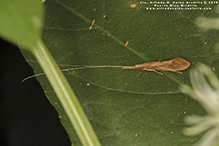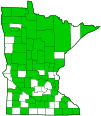Late long-horned caddisfly
(Triaenodes tardus)
Conservation • Description • Habitat • Ecology • Distribution • Taxonomy
Conservation Status |
|||
| IUCN Red List | not listed |
||
| NatureServe | N4N5 - Apparently Secure to Secure SNR - Unranked |
||
| Minnesota | not listed |
||
Description
Late long-horned caddisfly is a common small caddisfly. It occurs in North America mostly in the east and in the Pacific Northwest. In the United States it occurs from Maine and North Dakota south to Ohio and Kansas, and from Washington to northern California, with scattered records in between and in the south. It is common in Minnesota, where it is the second most widespread caddisfly species. Global Biodiversity Information Facility (GBIF) shows more records from Minnesota by far than from any other U.S. state or Canadian province. Larvae eat living plant material. They are found in the beds of submerged aquatic plants, both in the still water of wetlands and along the shores of lakes and ponds, and in the fast moving water of rivers and streams. Adults do not feed. They are usually found near the aquatic habitat of the larvae, but may wander up to several miles. They are active at night (nocturnal) and at dusk and dawn (crepuscular). They are attracted to light.
Adults are slender and 5⁄16″ to ½″ (8 to 12 mm) in length.
There are two compound eyes but no simple eyes (ocelli). The antennae are pale, thread-like, and long, more than twice as long as the forewings. On the first quarter of each antenna there is a dark brown band at the base of each segment. The mouth parts are reduced but the finger-like sensory organs attached to the mouth (maxillary palps) are well developed. On both sexes they have 5 segments. The last segment is not much longer than the other segments and does not have horizontal grooves.
The thorax has three exoskeletal plates above. The plate covering the first segment (pronotum) has a pair of warts separated be a deep notch. The plate covering the second segment (mesoscutum) has two irregular rows of closely spaced bristly spots.
There are 4 membranous wings. The hindwings are a little shorter than the forewings. The forewings are light brown with dark brown markings on the outer third. When the wings are at rest they are held roof-like over the body and the dark brown areas of each wing meet in the middle. No hairs on the forewings have an enlarged or swollen tip (clubbed). The median vein (M) has 4 branches on the forewing, 3 branches on the hindwing. The cubitus vein (Cu) on each wing has 3 branches. There is a small spot on each wing in the fork of the fourth and fifth branch of the radius vein (R4+5).
The legs are relatively long and slender. The fourth segment (tibia) of the middle leg does not have a row of spurs near the tip but does have a row of black spines. The last part of the leg (tarsus), corresponding to the foot, has 5 segments. At the end of each tarsus there is a pair of claws. The claws on the middle and hind legs are equal in length.
The larva is similar in appearance to a caterpillar. It constructs a portable protective tube up to 1 5⁄16″ (33 mm) long in which it lives. The tube is made of plant pieces arranged in a spiral pattern.
Size
Total length: 5⁄16″ to ½″ (8 to 12 mm)
Similar Species
Habitat
Lakes, streams, rivers, and wetlands; all habitat types.
Ecology
Season
One generation per year: May through September
Behavior
Adults are active at night (nocturnal) and at dusk and dawn (crepuscular). They are attracted to light.
Life Cycle
The female lays a flat oval mass of eggs.
Larva Food/Hosts
Plant fragments
Adult Food
Distribution |
||
|
Sources Biodiversity occurrence data published by: Minnesota Biodiversity Atlas (accessed through the Minnesota Biodiversity Atlas Portal, bellatlas.umn.edu, 9/27/2025). |
|
| 9/27/2025 | ||
Occurrence |
||
Common and widespread in Minnesota |
||
Taxonomy
Order
Trichoptera (caddisflies)
Suborder
Integripalpia
Infraorder
Brevitentoria
Superfamily
Leptoceroidea
Family
Leptoceridae (long-horned caddisflies)
Subfamily
Leptocerinae
Tribe
Triaenodini
Genus
Triaenodes
Subordinate Taxa
Synonyms
Triaenodes marginata tarda
Triaenodes mephitus
Triaenodes tarda
Common Names
late long-horned caddisfly
Glossary
Maxillae
Paired mouth structures of arthropods located immediately behind the mandible and used for tasting and manipulating food. “Under-jaws”.
Ocellus
Simple eye; an eye with a single lens. Plural: ocelli.
Palp
Short for pedipalp. A segmented, finger-like process of an arthropod; one is attached to each maxilla and two are attached to the labium. They function as sense organs in spiders and insects, and as weapons in scorpions. Plural: palpi or palps.
Pronotum
The exoskeletal plate on the upper side of the first segment of the thorax of an insect.
Tarsus
On insects, the last two to five subdivisions of the leg, attached to the tibia; the foot. On spiders, the last segment of the leg. Plural: tarsi.
Tibia
The fourth segment of an insect leg, after the femur and before the tarsus (foot). The fifth segment of a spider leg or palp. Plural: tibiae.
Visitor Photos
Share your photo of this insect.
This button not working for you?
Simply email us at info@MinnesotaSeasons.com.
Attach one or more photos and, if you like, a caption.
|
||
Alfredo Colon |
 |
MinnesotaSeasons.com Photos
|

Slideshows

Visitor Videos
Share your video of this insect.
This button not working for you?
Simply email us at info@MinnesotaSeasons.com.
Attach a video, a YouTube link, or a cloud storage link.
Other Videos



